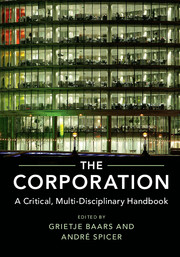Book contents
- Frontmatter
- Contents
- List of Contributors
- Acknowledgements
- Introduction: Why the Corporation?
- PART I DISCIPLINARY OVERVIEWS
- PART II INTERDISCIPLINARY THEMATIC CHAPTERS
- 1 The Evolution of the Corporate Form
- 2 The Multinational Corporate Group
- 3 The Financialization of the Corporation
- a The Financialization of the Corporation
- b Financialized Business Models and the Corporation
- c Transnational Corporations and the International Tax Haven and Offshore Finance System
- 4 Corporate Value Chains
- 5 Corporate Citizenship
- 6 The Corporation and Crime
- 7 The Corporation and Ideology
- 8 Corporation and Communities
- 9 Corporations and Resistance
- 10 Alternatives to the Corporation
- Index
- References
c - Transnational Corporations and the International Tax Haven and Offshore Finance System
from 3 - The Financialization of the Corporation
Published online by Cambridge University Press: 31 March 2017
- Frontmatter
- Contents
- List of Contributors
- Acknowledgements
- Introduction: Why the Corporation?
- PART I DISCIPLINARY OVERVIEWS
- PART II INTERDISCIPLINARY THEMATIC CHAPTERS
- 1 The Evolution of the Corporate Form
- 2 The Multinational Corporate Group
- 3 The Financialization of the Corporation
- a The Financialization of the Corporation
- b Financialized Business Models and the Corporation
- c Transnational Corporations and the International Tax Haven and Offshore Finance System
- 4 Corporate Value Chains
- 5 Corporate Citizenship
- 6 The Corporation and Crime
- 7 The Corporation and Ideology
- 8 Corporation and Communities
- 9 Corporations and Resistance
- 10 Alternatives to the Corporation
- Index
- References
Summary
The Law and Economics of the Corporation
The corporation is an artificial entity, created as a non-natural person by state law. Yet rarely is any close consideration given to the reasons for allowing companies to be formed, the purposes for which they may be justified, or the conditions and limitations which should be placed on their use. Incorporation is taken for granted and generally treated as a right rather than a privilege. It is accepted as natural that the company form can be used for virtually any activity. It has indeed been adapted and used flexibly, largely resulting from the creative work of corporate lawyers, who have also exploited its potential well beyond the limits suggested by its economic justifications.
The foundation for the economic theory of the firm in institutional economics is the seminal essay of 1937 by Ronald Coase proposing a microeconomic analysis of the firm in terms of the transaction costs of markets versus coordination. From this perspective, the firm exists to the extent that the internalization of activities and relationships within the firm through its administrative arrangements is more efficient than managing them by contracts between independent actors. In Coase's view, the efficiency of markets requires analysis of the transaction costs of contracting, but he also introduces consideration of the nature of the firm as an institution, since there are also costs involved in managing a bureaucratic organization, which pose limits to its growth.
Coase's view of the firm as a system of planned coordination focused on the production factors which would be more efficient to coordinate administratively rather than through contracting. He concluded that this is most likely to be so when the content of a contract is hard to specify in advance, and that this is especially so for labour (1988: 39–40). Perhaps surprisingly for some, this is an essentially Marxist perspective (Campbell and Klaes, 2005), although Coase takes a more benign view of the ability of capitalist management to extract surplus value from labour power. The extension of limited liability in the mid-nineteenth century in the UK was motivated by arguments for encouraging economic activity for worthy purposes, and the Act of 1856 was sparked by Christian socialists, who argued for a legal form to facilitate workers’ cooperatives (Saville, 1956).
- Type
- Chapter
- Information
- The CorporationA Critical, Multi-Disciplinary Handbook, pp. 303 - 312Publisher: Cambridge University PressPrint publication year: 2017
References
- 1
- Cited by



